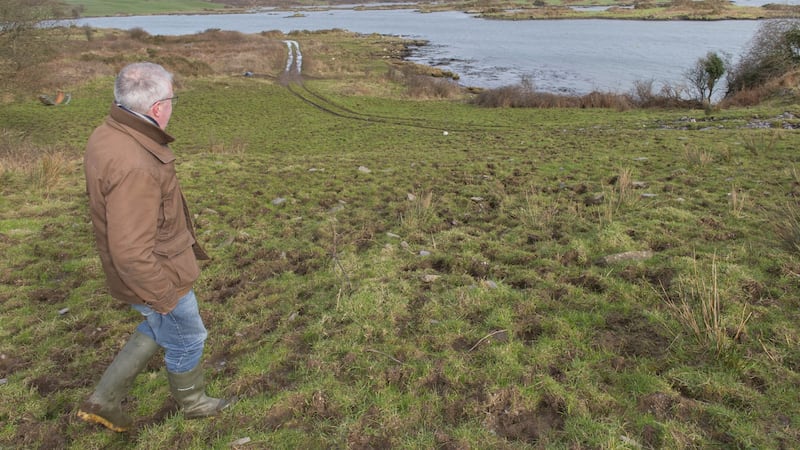Across the water the odd light twinkles on Heir Island. It’s an idyllic evening and the retiring sun shoots a last glance at Jeremy Iron’s castle dressed in its unusual orange.
We’re standing by the shore at Skeaghanore West near Ballydehob. Remote and beautiful spots, just like this, are now coveted by those who seek the beauty and solitude of West Cork – but this was once a place where untold sadness lingered.
In Famine times, people from neighbouring parishes would make the long walk to this spot to gather shellfish in a desperate attempt to stay alive. Exhausted and starved, many died once here and are buried in a cillín overlooking the shore.
With local historian William Casey I attempt to get a closer look at the grave, located on a former ecclesiastical site, pulling back the thick coverage of briars and torn bushes.
“You could have hundreds of Famine victims here,” explains Casey.
“Grown men and women as well as children. This was their last attempt to live but when they lost that battle for life they’d be carried here and laid to rest, one after the other.”
Though cillíní are generally recognised as unofficial burial grounds for unbaptised children, records show that adults, such as Famine victims, were often buried in them too.
And it’s shocking to discover why so many Irish adults were deemed unworthy, by the Catholic Church and wider society, of a traditional burial down through the centuries.
Those who died by suicide, sailors, strangers, mothers who died in childbirth, criminals, murder victims, those with mental illnesses or physical deformities, people who died in a duel, excommunicates, were laid to rest in remote cilliní alongside little babies and children.
"Canon law lists 'Those to Whom Ecclesiastical Funeral Rites Are Denied'," explains Dr Eileen Murphy, an archaeologist at Queen's University Belfast, who has studied cillíní closely.
She continues: “While most people buried in cilliní were unbaptised infants we also have examples of older individuals such as a pregnant woman in the cillín at Tonybaun, Co Mayo. Her skull displayed unhealed weapon injuries and I think it is the violent nature of her death that may have necessitated her burial in the cillín. We also have a newspaper account from Co Down of the body of a suicide victim who died 30-years previously and was discovered in 1842.”
Tom Cassidy, Conservation Officer with Limerick County Council, worked on an archaeological survey of Co Galway in the early 1980s.

He says: “Galway has the highest concentration of recorded cillíní in the country. We came across a burial ground near Gort where two adults were said to have been buried. One was a British soldier who met his end during the War of Independence (from 1919 to 1921) and was buried in a cillín so his body wouldn’t be found. The other, we believe, was a man who was killed in a faction fight during a fair in the town. You could see from the stone markers that these weren’t infant’s graves.”
Incredibly some cillíní were still in use up to the early 1980s. Officially there are 1,393 cilliní in the State but most historians believe this figure is a mere fraction of the real number.
Emer Dennehy, an archaeologist now working with Transport Infrastructure Ireland, explains that in some cases mothers and babies who died in childbirth were buried together.
“In some cases it’s recorded that the baby would be buried between the mother’s legs in what were known as ‘tandem burials’. And if the mother died without being ‘churched’ (a blessing given to mothers after recovery from childbirth) then she could be buried in a cillín as well.”
Dennehy carried out one of the most detailed studies into cillíní when she surveyed the hundreds of such burial grounds in Co Kerry. She told me about the logic behind the traditions – especially as they related to suicide victims.
“The thinking which came from the church was ‘if you bury the person who died by suicide in a normal graveyard then they will contaminate it for everyone else buried there’. It was all about fear. They reckoned that only God could decide when you die so these people weren’t welcome. It was considered they, and so many others, ‘died outside the Grace of God’ and the Church completely played on this.”
Understandably, families, so desperately fearful of the stigma associated with suicide, would attempt to cover up the cause of death.
It’s believed this practice continued well into the 20th century so that a conventional burial could be granted.
For many, interment of an adult family member in a cillín was the worst shame to be endured.
Archaeologist Noel Dunne tells of "Mags Kilteel" – discovered by a passing merchant as an abandoned baby in Kildare around the 1890s, she became part of the Broderick family. But when she died, in her mid-20s, she was interred in a cillín rather than with the rest of her adopted family. Forever an outsider.
A range of unsettling practices in cillíní have been recorded. According to folklore some children were buried face down if they were handicapped or illegitimate or when childbirth almost resulted in the mother’s death.
Along the coast, sailors, and other unknown individuals washed up on the shore, were buried in cillíní. Written accounts provided by the National Folklore Collection confirm sailors were buried on the Great Blasket Islands. Similarly, we know sailors were laid to rest at a cillín in Renvyle, Co Galway, as well as in Dooks, Co Kerry, and on Heir Island.
While convicts and criminals would also have been buried in unconsecrated ground Dr Linda Lynch, an Osteoarchaeologist, explains that most would not have been buried in cillín.
“As cillíní are mainly located in rural areas, its less likely convicts would be buried there. It would be more usual for them to be buried near prisons and urban centres – in prison graveyards.”
Like this cillín in West Cork, many such graveyards across the country are left untouched by farmers and landowners who know not to encroach on these places of mass burial.
Buried, too, beneath the thorns, the gorse bushes, the long grass and the ferns are stories of unimaginable pain, suffering and tragedy.
In many cases stones mark out the dimensions of the infant’s grave but what of the larger dimensions, the last resting places of so many adults labelled inferior to those buried in graveyards.
Shunned in life and then in death.















